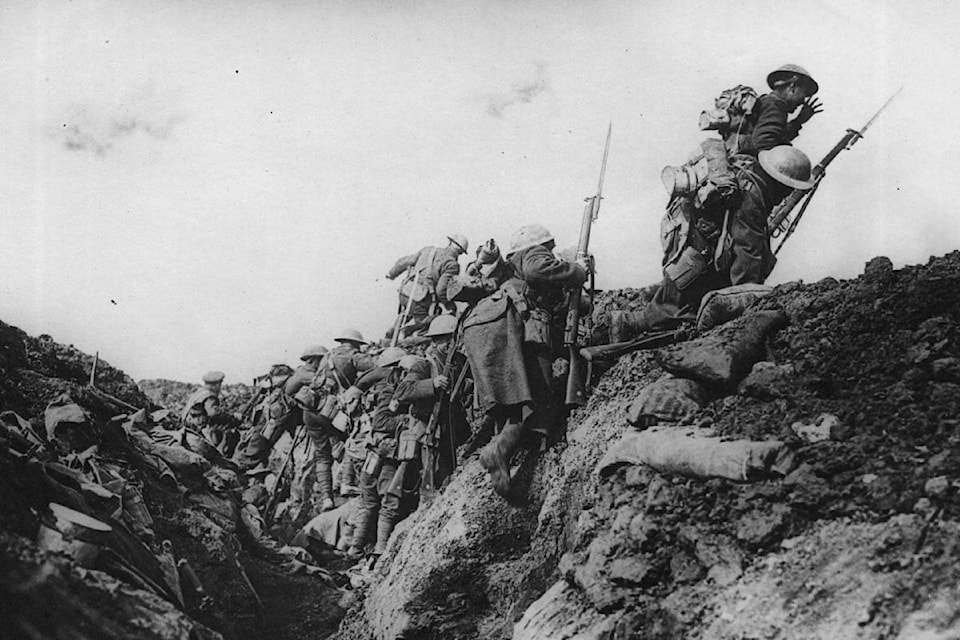This year marked the 100th anniversary of the Battle of Vimy Ridge.
It was a milestone that was not overlooked as millions around the world stopped to mark the occasion. An estimated 25,000 Canadians attended ceremonies on April 9 near Arras France, including a number of West Shore and Island residents.
The Battle of Vimy Ridge, which took place in April 1917, is Canada’s most famous military victory. For the first time in the Great War, all four Canadian divisions of the Canadian Expeditionary Force, commanded by Lt.-Gen. Sir Julian Byng, fought together. The monument, designed by Toronto architect Walter Allward, is situated at Hill 145 on Vimy Ridge, the highest point of the ridge.
RELATED: Royal Canadian Legion Branch 91 adds new memorial to Veterans Memorial Park
Closer to home, a scale version of that momument stands at Veterans Memorial Park in Langford. Two weeks ago, members of the Royal Canadian Legion Branch 91 and members of Langford’s council added another memorial to the site by planting an acorn tree to remember those who have fought for our freedom. The tree grew from an acorn that is from Vimy Ridge.
Vimy Ridge was the anchor of the German northern lines. The French failed to capture it in the spring and fall of 1915, suffering 140,000 casualties, including 40,000 fatalities. The British relieved the French in March 1916, continuing the tunnelling war where British and German engineers continued to carve tunnels and dugouts in the limestone or chalk ridge and detonate large mines under each other’s lines.
After the Battle of the Somme (July to November 1916), the Canadians began arriving at Vimy and described their new location as a dirty, muddy place with endless numbers of rats and constant enemy fire.
The Canadians were assigned to take the ridge as part of the larger British Battle of the Scarpe, a diversion of the larger General Robert Nivelle’s French campaign to breakthrough the German lines in the Champagne Region of France.
Approximately 100,000 Canadians took part in the Battle of Vimy Ridge, which lasted from April 9 to 12, with about 25,000 in the infantry. An equal number of Brits were also involved in the battle with most of these engineers, gunners, members of the Royal Flying Corps, and only one brigade of infantry.
READ MORE: History, community help mark the 100th Anniversary of the Battle of Vimy Ridge
The Canadians attacked a four-mile front up the gradual western slope before descending the more abrupt eastern slope to the final line. But before that, on March 20, the British and Canadians launched a three-week preliminary bombardment that resulted in the destruction of 83 per cent of the German gun batteries and defensive strongholds. The Germans referred to the last week of the bombardment as “the week of suffering.”
The continual barrage prevented the Germans from supplying rations and reinforcements to their lines.
Canadian troops also carried out numerous patrols and 55 raids against the Germans prior to April 9. Most were successful with the exception of a large gas raid on the night of February 28 that went awry when the wind shifted, causing more than 600 Canadian casualties.
On April 9, the battle opened at 5:30 a.m. with gunfire that was heard in England. Fifteen thousand Canadians went over the top, advancing behind a creeping barrage of the 18–pounder field guns lined up almost wheel-to-wheel along the four mile front, that included the sweeping fire of 150 Vickers machine-guns 400 yards in front of the advance.
The attack worked like clockwork with the 1st , 2nd, and 3rd Divisions reaching the German front lines, code–named the Black Line, by 6:15 a.m. The fire was so intense that most Germans were kept underground, not knowing that the attack had started.
Only at the heavily–defended Hill 145 where the commander of the 87th Battalion requested that the gunners spare a 100-yard section of trench to be used by the Canadians as a headquarters trench, did the attack not go well. The 4th Division, faced with literally wading through mud and avoiding the large number of water-filled shell holes, lost the barrage from the get–go and were mowed down by German machine guns. The 102nd Battalion (Northern B.C.), advancing on the right flank of the 4th Division, fared better than the other battalions. The capture of Hill 145 wasn’t finalized until the afternoon of April 10.
The final objective, the Pimple, a height of land north of Hill 145, was taken in a blinding snowstorm on the morning of April 12, thus completing the battle. The Canadians suffered 10,000 casualties at Vimy Ridge, 3,598 of those fatal. Many men died of exposure, lying in the cold, wet, and snow before stretcher–bearers could reach them.
The Battle of Vimy Ridge allowed the British and Canadians to capture this impregnable high ground and to retain it for the rest of the war.
The Canadian victory was an Allied morale booster and changed the nature of warfare in World War I. The victory came at a dark time in the war for the Allies following the heavy losses at the Battle of the Somme in 1916. It was the first major Allied offensive victory of the war.
One Canadian soldier recalled: “Nothing could stop us, and when I went back, there was a great crowd of people when I came in. All of sudden one of the citizens said, ‘The Canadians have taken Vimy, nobody did it before!’ And what a cheer went up; they threw chocolate bars; they threw flowers. We achieved something that had not been done before. I myself think that is where Canada was born!”
-With files from Ken MacLeod /Special to Black Press
Find more Remembrance Day features on the Gazette’s website.
